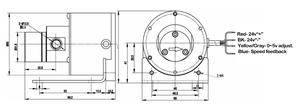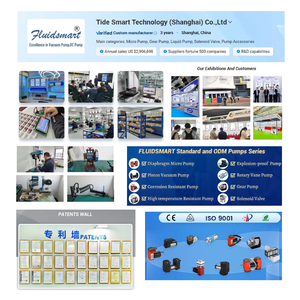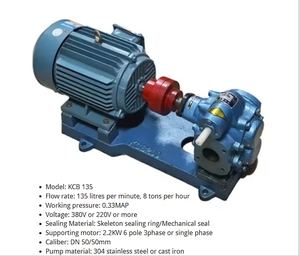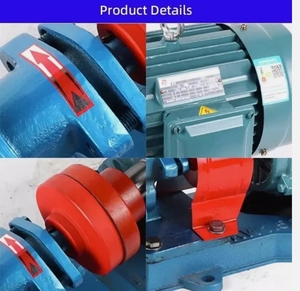
All categories
Featured selections
Trade Assurance
Buyer Central
Help Center
Get the app
Become a supplier

(169214 products available)

































External Gear Pumps
In external gear pumps, the two gears are situated close to each other but not touching. This allows one to pull fluid into the pump's cavities between the gear teeth and then push the fluid out through the discharge. These are mainly used for:
They are versatile, serving various industries, including food processing, oil and gas, and chemical manufacturing.
Internal Gear Pumps
In internal gear pumps, one gear is positioned inside the other, creating a more complex but effective sealing and fluid movement mechanism. This design enhances the pump's ability to handle:
The tight meshing of the gears also reduces pulsation, resulting in a consistent fluid flow. Internal pumps are often used in:
Lubrication systems and in industries such as automotive
Compound Gear Pumps
Compound gear pumps comprise two or more different types of gears, such as a combination of external and internal gears. This complex setup allows for more versatile and efficient fluid transfer, especially for liquids with:
This allows for a more effective sealing and mixing, benefiting industries where fluid composition can vary significantly. Such industries include:
This design ensures consistent performance even under fluctuating conditions.
Gear Vane Pumps
Gear vane pumps integrate the principles of both gear and vane pumps. This allows for smooth fluid transfer while providing the benefits of a gear's pressure capability and a vane's fluid sealing. These pumps are valued for their ability to handle:
They are commonly used in the pharmaceutical and cosmetics industries, where maintaining fluid integrity is essential. Their compact design also makes them suitable for limited-space applications, enhancing their versatility in various high-tech sectors.
Gear pumps are extensively applied in varying industries. Their choice of material is therefore vital to ensure they perform effectively. The material selection greatly affects the durability of the pumps. The following are common materials used in the gear pumps for their durability:
Cast Iron
Cast iron is commonly used in gear pump housing due to its balance of strength, durability, and affordability. This rugged material can withstand heavy use in industries like construction and manufacturing. These are companies where the environment is demanding. Cast iron is also resistant to wear, making it what is called a long-term solution for pumps handling viscous fluids. In addition, cast iron's ability to absorb vibrations enhances the pump's longevity and reliability in high-impact settings.
Stainless Steel
In stainless steel gear pumps, the parts are made with stainless steel. Stainless steel is renowned for its strength and corrosion resistance. This makes it ideal for food and chemical processing industries. In these industries, harsh chemicals or varying temperatures can deteriorate other materials. Stainless steel also offers excellent durability against wear and tear. This ensures these gear pumps maintain long-term performance even with continuous heavy usage.
Aluminum Alloys
Aluminum alloys used in gear pumps provide a lightweight yet durable option. This makes them ideal for applications where ease of installation and mobility are crucial. Commonly found in automotive and aerospace sectors, these pumps handle low to moderate-viscosity fluids. While not as wear-resistant as cast iron or stainless steel, aluminum alloy pumps offer a cost-effective solution for less demanding environments. These are industries that still require reliable performance.
Bronze and Brass
Bronze and brass are commonly used for gears in gear pumps. These materials offer excellent wear resistance and minimal friction. These qualities are vital for the durability of the gears themselves. Found in marine applications and situations where the pump handles corrosive fluids. Bronze and brass pumps ensure long-term functionality without frequent repairs. Their ability to maintain gear integrity over time makes them indispensable in ensuring consistent performance in all fluid transfers.
Industrial-Grade Polymers
Industrial-grade polymers are used in gear pumps for lightweight and corrosion-resistant properties. Commonly used in applications involving aggressive chemicals or where electrical conductivity is a concern. These pumps maintain durability while minimizing maintenance costs. Their resistance to wear also makes them suitable for varying industries. These industries are commonly experiencing engineers and technician cost issues. These pumps help mitigate those costs while still offering ample durability for demanding industrial applications.
Gear pumps are preferred for their dependability in transferring liquids of varying viscosities. These pumps also offer buyers savings in the following ways:
Increased Energy Efficiency
Gear pumps efficiently convert mechanical energy into fluid movement. This minimizes energy losses during transfer. Whether in hydraulic systems or industrial processes, their smooth operation means less power is required to achieve the same results.
Versatile Applications
Gear pumps are highly applicable in the oil and gas sector. These sectors use both internal and external gear pumps. Oil and gas industries widely use these pumps for extracting, transporting, and refining oil and gas. They manage thick crude oil and natural gas with precision and reliability.
In chemical processing, they withstand corrosive substances. In this case, they also apply chemicals used for mixing and transferring chemicals. Thereby ensuring the durability of the gear pumps is maintained. Moreover, these industries have a wide variety of liquids that require different gear pumps.
That is why gear pumps are highly adaptable. They also ensure consistency in such variable industries.
Minimal Downtime
Gear pumps have continuous operation resulting in minimal maintenance requirements. This property translates to less downtime for operations. This is especially in critical applications such as manufacturing and mining. Where every minute counts. Their durability and reliability contribute to longer operational periods. This means less time allocated to repairs and maintenance.
Cost Savings on Maintenance
Gear pumps have durable constructions that withstand wear and tear. This ensures less frequent maintenance and replacement of parts, leading to significant cost savings over time. So whether for industrial or commercial use, the savings on maintenance can be substantial. Especially when considering the long-term operational requirements.
Strong Return on Investment
Businesses gain long-term, dependable performance with a low total cost of ownership. Gear pumps can handle harsh conditions, yielding a high ROI. They also provide consistent fluid transfer, improving productivity and efficiency. Their durability and efficiency, therefore, make them a smart investment for various industries.
Power Supply Compatibility
This is to say that the chosen gear pump should be compatible with the current power supply. For electrical motors, ensure the voltage and frequency requirements align to prevent operational issues. Always consider the motor type to be used. Will it be an AC or DC motor? Will the motor be connected directly to the pump or via belts? This will determine what the gear pump should be compatible with.
Fluid Characteristics
One must, therefore, assess the liquid that the pump will handle. Consider the viscosity, chemical nature, and temperature. This will determine the appropriate gear material. Those with high viscosity will require stronger materials like cast iron or stainless steel to withstand pressure. Beware of the chemical composition to determine if it will corrode the part. Moreover, evaluate the temperature range to decide whether to have a pump that can handle extreme temperatures. That is, either through material selection or seals.
Displacement and Flow Rate
This displacement refers to the fluid volume moved per each rotation of the motor. While the flow rate refers to the total fluid volume moved over a certain period. Higher displacement and flow rates are better for large operations requiring more fluid to be moved in a shorter period. Smaller operations will do just fine with a lower displacement and flow rate.
Mechanical Seal vs. Packing Seal
A mechanical seal is a better option for gear pumps that handle high viscosity fluids. These are for applications where there is high pressure to be expected. It works well in petrochemical industries. The packing seal will be ideal for low viscosity fluids or standard operating conditions. It is commonly used in food processing industries due to its easier maintenance and lower cost.
Market Reviews
One should look into the reviews of various gear pumps from reputable manufacturers. Focus on their performances in similar applications. It will also be useful to consider the quality of customer service experiences. More importantly, what do other businesses say about the reliability and durability of the gear pumps over time? This will also help in selecting a reputable manufacturer. This is because, other than quality, one also needs a manufacturer with quality customer service.
Q1. What are the signs that a gear pump is failing?
A1. There are many indicators of gear pump failure. The main one is continuing pressure drop. It indicates that the pump is no longer able to maintain the required displacement of fluid. Pump noise is also a sign of failure. Excessive noise or vibration indicates mechanical wear or internal damage. Inconsistent flow rates mean the pump is not displacing fluid at a consistent rate. Lastly, discoloration of fluid is an indicator. This means that the wear debris is contaminating the fluid leading to possible system malfunctions.
Q2. What maintenance practices can increase a gear pump's lifespan?
A2. Regularly checking and replacing the oil whenever necessary will help increase the gear pump's lifespan. As will examining all components to replace worn-out parts. Installing strainers and filters to capture contaminants will also do the trick. Frequent inspection of the gear pump for indications of failure will also increase its lifespan. As will following the manufacturer's recommendations for maintenance.
Q3. Can a gear pump be used for adhesive handling?
A3. Yes, for as long as the adhesive is not prone to foaming.
Q4. What kind of repair can prolong a pump's current state?
A4. Repairs like replacing internal parts such as rotors, gears, stators, etc., can prolong a pump's current state. A rebuild can also be done with either new or refurbished parts.
Q5. What will happen if a gear pump is allowed to run dry?
A5. Running dry causes overheating, leading to the expansion of the seals and subsequent damage to the pump internals. This also increases friction and wear on the gears. The fluid acts as a lubricant. Not having it leads to increased wear and tear. The mechanical seal will also be damaged due to overheating.